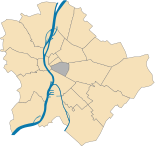Józsefváros
|
VIII. Budapest District Józsefváros ( German Josefstadt) |
|||
|
|||
| Basic data | |||
|---|---|---|---|
| State : | Hungary | ||
| Region : | Central Hungary | ||
| County : | Budapest | ||
| Coordinates : | 47 ° 29 ' N , 19 ° 4' E | ||
| Area : | 6.85 km² | ||
| Residents : | 84,300 (Jan. 1, 2011) | ||
| Population density : | 12,307 inhabitants per km² | ||
| Postal code : | 1081-1089 | ||
| KSH kódja: | 25405 | ||
| Structure and administration (as of 2020) | |||
| Community type : | district | ||
| Structure : | Districts
|
||
| Mayor : | András Pikó ( Momentum - DK - MSZP - Párbeszéd - LMP ) | ||
| Postal address : | Baross utca 63-67 1082 Budapest |
||
| Website : | |||
| (Source: A Magyar Köztársaság helységnévkönyve 2011. január 1st at Központi statisztikai hivatal ) | |||
The 8th district of the Hungarian capital Budapest , which is also called Józsefváros ( German Josefstadt ), is located on the east bank of the Danube in the former city of Pest and is one of the oldest districts of Budapest.
history
The history of the capital Budapest and the Józsefváros are inextricably linked. The first settlers of the lower suburbs of Pest appeared around 1720. Horticulture was practiced on the fertile soil in front of the city walls of Pest, and wine and grain were grown further away. The poor soil, the pastures offered opportunities for cattle breeding. This also determined the employment of the first settlers.
In the area of today's Josefstadt there were 20 dairy farms between the fields around 1710 . The first 27 parcels were created when Josef Kastberger, councilor of the city of Pest, sold his field in 1732. The area and the neighboring area were built on in a few years. The spot was named Pacsirtamező (Lark Field). In 1764 there were only seven, two decades later there were already twenty-five streets. The organization of the suburb followed the rapid development. From 1733 it had its own judge, in the person of the brickworks owner Mátyás Pindtner. In 1766 the area was divided into the Upper and Lower Suburbs. At the request of the residents, the latter received the name Josephstadt, Józsefváros, from the Palatine Hill on November 7, 1777, after the son of Maria Theresa , the heir to the throne Joseph .
The development of the municipality was interrupted by the floods in 1838. Of the 1,255 houses, 891 were destroyed, 115 heavily damaged, only 149 buildings remained. The devastating catastrophe also had beneficial effects. After the water withdrew, the reconstruction began immediately. The street layout was not changed, the plan of the architect József Hild was applied to the newly developed areas . The construction work also created new job opportunities.
In 1873, when Pest, Buda and Óbuda joined Budapest, Józsefváros was already a small town with 62 streets. For the millennium of the conquest in 1896, there were already 37 businesses and factories here. The area was built on more and more, the number of residents increased. In addition to residential houses, a number of palaces were built. In 2002 the district celebrated its 225th anniversary.
description
The district is one of 23 in the capital. In the Josefstadt are the Keleti pályaudvar (Ostbahnhof), the National Museum and the palace district, where many aristocrats once lived. The Esterhazy and Károlyi Palaces are part of the surrounding area. The Budapest City Library, located in the renovated Wenckheim Palace, is one of the busiest in Europe. Some of the 8,000 visitors a day come from the universities in the district. The Catholic University, the Philological Faculty, the Medical University and the German-speaking Andrássy University are at home in Josefstadt .
The two oldest museums in Hungary, founded in 1802, are the aforementioned National Museum and three metro stops away are the Natural History Museum. The former central cemetery of Budapest, which is located in the district and now houses the national pantheon, is also of museum value. One city within the city is the employee colony with small single-family houses. A small village, the artists' colony, which has existed for 80 years, where the painters and sculptors have their studios and also live there. This is also where the Stalin statue was made, with the demolition of which the revolution began in 1956 . Another battleground on October 23 was the radio building . The heaviest fighting was fought in this district.
For literature lovers, the botanical garden and an important setting for the novel by Ferenc Molnár " The Boys from Paulstrasse ". Paulstrasse, where Molnár lived in his childhood, is also in Josefstadt. The party headquarters of the Socialist Party and Fidesz are also located in Josefstadt. There were once important industrial plants in the district. The Ganz & Cie factory, founded in the 19th century by the Swiss Ábrahám Ganz , exported locomotives all over the world until the 1980s. Today the halls are home to some small businesses and, together with the Josefstädter Bahnhof opposite, the city's largest Chinese market.
A successful Hungarian animation film, a traditional Romeo and Juliet story, which won an award in 2005 , is also set in Josefstadt.
Partnerships
The district maintains the Federation of Josef cities partnerships with the also eighth Vienna District Josefstadt and with the eponymous district Iosefin in Romanian Timişoara .
photos
Hungarian Natural Science Museum on Ludovika Square





